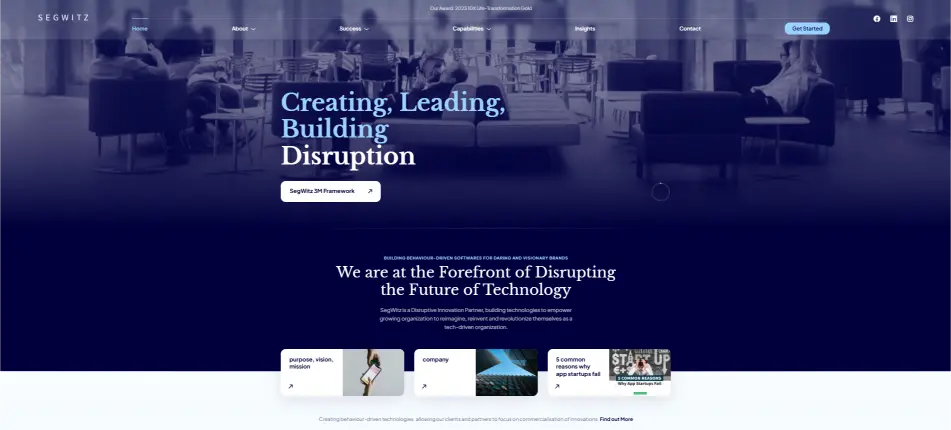In today’s digital world, your website is often the first interaction potential customers have with your brand. But what happens when that interaction isn’t as smooth or personalised as it could be? The answer is simple: you lose customers. This is where customer-centric web design comes into play.
Customer-centric web design is about putting the needs, preferences, and behaviours of your users at the forefront of the design process. It’s not just about creating a website that looks good; it’s about crafting an experience that resonates with visitors, builds trust, and ultimately turns them into loyal customers. But how exactly does this work? And why is it so crucial for businesses in today’s competitive online landscape?
In this guide, we’ll explore the benefits, key elements, and practical steps to help you create a customer-centric website that drives engagement and boosts your ROI.
1. Understanding Customer-Centric Web Design
A. What Does a Customer-Centric Website Look Like?
A customer-centric website is more than just a functional digital space—it’s a carefully crafted experience that anticipates your visitors’ needs and preferences. This involves not only designing a clean, attractive website but also ensuring that everything on the site serves the customer’s journey. From easily accessible information to personalised recommendations and seamless navigation, every decision made during the design process should aim to improve the visitor’s overall experience.
B. The Difference Between Traditional Web Design and Customer-Centric Design
Traditional web design often focuses on aesthetic appeal and general functionality, assuming a one-size-fits-all approach. However, customer-centric design goes a step further by making the user’s experience the primary concern. It involves user research, data analysis, and continuous feedback to tailor the website’s design to meet the unique needs and expectations of your specific audience. The result is a site that feels intuitive, relevant, and responsive to the individual needs of each visitor.
2. Why Prioritising the Customer Experience Pays Off
A. The Impact on Customer Engagement
Customer engagement is critical to the success of any website. When a site is designed with the user in mind, visitors are more likely to interact with content, spend more time exploring products, and engage in calls to action. A seamless, user-friendly design keeps them interested, whereas a confusing or frustrating experience can lead to a quick bounce.
B. How It Influences Conversions and Retention
Conversion rates are significantly impacted by the user experience. When a website caters to the needs of its visitors—providing them with the right information at the right time, with clear pathways to purchase or contact—you’ll see higher conversion rates. Furthermore, by ensuring the experience is positive and personalised, you’ll boost customer retention. Happy, satisfied customers are more likely to return and make repeat purchases, forming the foundation for long-term business growth.
Case Study: A Business That Thrived from a Customer-Centric Approach
Take the example of Amazon. From the moment you land on Amazon’s homepage, you’re greeted with personalised recommendations based on previous purchases, browsing history, and even current trends. Its streamlined navigation, quick-loading pages, and clear calls to action make the shopping experience incredibly simple and enjoyable. This customer-centric approach has played a massive role in Amazon’s success, helping it become a leader in e-commerce globally.
3. Core Elements of Customer-Centric Web Design

A. User-Friendly Navigation: The Importance of Easy-to-Find Information
Visitors to your website should be able to find what they’re looking for without frustration. A clean, intuitive navigation structure—one that highlights your most important pages—is crucial for creating a positive user experience. Include clear headings, a well-organised menu, and search features to ensure visitors can easily find information with minimal effort.
B. Personalisation: Customised User Experiences That Drive Loyalty
Personalization is one of the most powerful tools in a customer-centric website. By using data such as browsing behaviour, location, or past interactions, you can create tailored content that appeals directly to individual users. Whether it’s personalised product recommendations, location-specific offers, or dynamic content based on a visitor’s preferences, customization shows your customers that you understand them.
C. Accessibility: Designing for All Users, Including Those with Disabilities
A truly customer-centric website is accessible to everyone, regardless of their abilities. Consider accessibility features such as alt text for images, keyboard navigation, and compatibility with screen readers. An accessible site not only ensures that you comply with regulations but also demonstrates a commitment to inclusivity, which can strengthen your brand reputation.
D. Mobile-First Design: Optimising for the Mobile Consumer
More than half of global web traffic now comes from mobile devices, making mobile-first design essential. A customer-centric website must look and function flawlessly on smartphones and tablets, offering responsive layouts and touch-friendly navigation. By prioritising mobile optimization, you cater to the growing number of mobile shoppers and ensure an excellent user experience across all devices.
E. Page Load Speed: How Fast Performance Affects Customer Experience
A slow-loading website can result in high bounce rates and frustrated users. Studies show that 40% of visitors will abandon a site if it takes more than 3 seconds to load. Optimising images, leveraging caching, and choosing a reliable hosting service are all critical for improving page load speed and ensuring a smooth experience for visitors.
4. The Role of Data in Customer-Centric Web Design
A. Gathering Customer Insights: How Data Shapes Your Design Decisions
Data plays a pivotal role in customer-centric web design. By collecting user behaviour data through tools like Google Analytics, heatmaps, and user feedback, you can identify pain points, understand what your customers want, and optimise the design accordingly. This data-driven approach helps ensure that your design decisions are based on real user needs rather than assumptions.
B. Analytics Tools for Understanding User Behaviour
Analytics platforms such as Google Analytics, Hotjar, and Crazy Egg provide invaluable insights into how visitors interact with your website. You can see which pages are most popular, where users drop off, and what actions they take. This data helps refine user flows, optimise content placement, and ensure your design is aligned with user preferences.
C. A/B Testing: Refining Your Website Based on Real-Time Data
A/B testing allows you to test different versions of a webpage to see which performs better in terms of engagement, conversions, and user satisfaction. This data-driven process helps you fine-tune your website’s design over time, ensuring it remains customer-centric and effective.
5. Turning Visitors into Loyal Customers
A. How to Build Trust with Seamless User Experiences
Trust is the foundation of customer loyalty. A seamless, well-designed website builds trust by delivering consistent, positive experiences. Simple details such as clear contact information, security badges, easy-to-understand terms and conditions, and smooth checkout processes help build confidence and encourage visitors to take the next step.
B. Emotional Connection: Creating an Experience That Resonates
Creating an emotional connection with your visitors is one of the most powerful ways to convert them into loyal customers. This can be achieved by telling your brand story, offering value-driven content, and ensuring the overall website tone resonates with your target audience’s needs and aspirations.
C. Encouraging Repeat Visits and Building Brand Loyalty
Your website isn’t a one-off touchpoint—it’s a critical part of the long-term customer journey. By providing ongoing value, whether through helpful resources, loyalty programs, or personalised experiences, you can encourage repeat visits and foster brand loyalty.
6. Measuring the ROI of a Customer-Centric Website
A. Key Metrics for Tracking Success
To gauge the effectiveness of your customer-centric design, focus on metrics such as conversion rates, bounce rates, average session duration, customer satisfaction scores, and net promoter scores (NPS). These metrics help determine if your design is resonating with your audience and achieving your business goals.
B. How to Calculate ROI from Design Improvements
Measuring ROI in web design goes beyond immediate financial returns. You can calculate it by tracking changes in engagement, lead generation, and customer retention after implementing design improvements. By analyzing the impact of these key metrics, you can estimate the long-term value of your design decisions.
C. Tools and Software to Help Measure ROI
Tools like Google Analytics, HubSpot, and Kissmetrics allow you to track user behaviour and key performance indicators (KPIs) that demonstrate the ROI of your customer-centric design efforts. These platforms offer detailed reports and insights to help refine your strategy over time.
7. Practical Steps to Implement Customer-Centric Web Design
A. Conducting User Research and Persona Development
Before diving into design, it’s important to understand who your target customers are. Conduct user research through surveys, interviews, and data analysis to build user personas that represent your ideal customers. These personas will guide design decisions and ensure that your website meets real user needs.
B. Continuous Design Improvement and Feedback Loops
Customer-centric web design isn’t a one-time project. It’s an ongoing process of iteration and refinement. Regularly collect feedback from users, test new features, and make design improvements based on real-world usage and feedback.
C. Collaborating Across Teams for a Holistic Approach
Creating a truly customer-centric website requires collaboration across multiple departments, from design and development to marketing and customer service. Ensure that all teams are aligned in their understanding of customer needs and work together to create a seamless, consistent experience.
8. Common Mistakes to Avoid in Customer-Centric Web Design
A. Overcomplicating the User Experience
Simplicity is key to a positive user experience. Avoid overwhelming visitors with too much information, complicated navigation, or a cluttered design. A streamlined, focused approach keeps visitors engaged and ensures they can quickly find what they need.
B. Ignoring Mobile Responsiveness
With mobile traffic on the rise, failing to prioritise mobile responsiveness is a critical mistake. Ensure your website is fully optimised for mobile users by testing it on different devices and screen sizes.
C. Failing to Prioritise Website Speed
Slow websites are a surefire way to lose visitors. Page load speed should always be a priority in your design process. Implement strategies to optimise speed and test regularly to maintain a fast, efficient website.
Conclusion
Customer-centric web design is not just a trend; it’s a strategic approach that can drive engagement, increase conversions, and build brand loyalty. By putting the needs of your customers first, focusing on personalization, and using data to guide your decisions, you can create an experience that resonates with visitors and turns them into loyal customers.
To learn more about customer-centric web design, read our comprehensive guide on website development for more best practices!
The key takeaway? Your website should be as much about your customers as it is about your brand. With a customer-centric design, you’re not just creating a website—you’re building relationships, fostering trust, and ensuring long-term success for your business.
Ready to start your journey toward a customer-centric website? Reach out to our team and begin crafting an experience that puts your customers first.





 Booking System
Booking System eCommerce
eCommerce On-Demand Services
On-Demand Services Community App
Community App Ordering App
Ordering App Loyalty App
Loyalty App Online Learning
Online Learning Directory
Directory Marketplace
Marketplace SaaS
SaaS P2P Platform
P2P Platform eHailing
eHailing Healthcare
Healthcare Finance
Finance Logistics
Logistics Education
Education Food & Beverage
Food & Beverage Retail
Retail FMCG
FMCG Sports
Sports Travelling
Travelling Manufacturing
Manufacturing Renewable Energy
Renewable Energy Mobile Application Development
Mobile Application Development Web Application Development
Web Application Development Source Code Review
Source Code Review Internet of Things (IoT)
Internet of Things (IoT) Cyber Security
Cyber Security